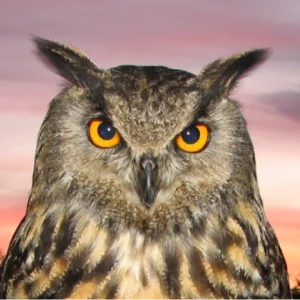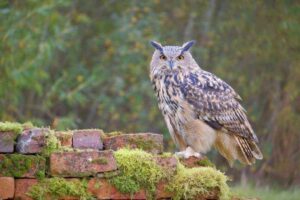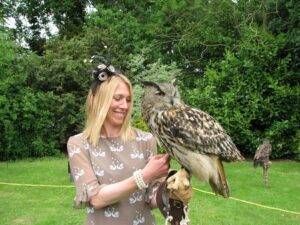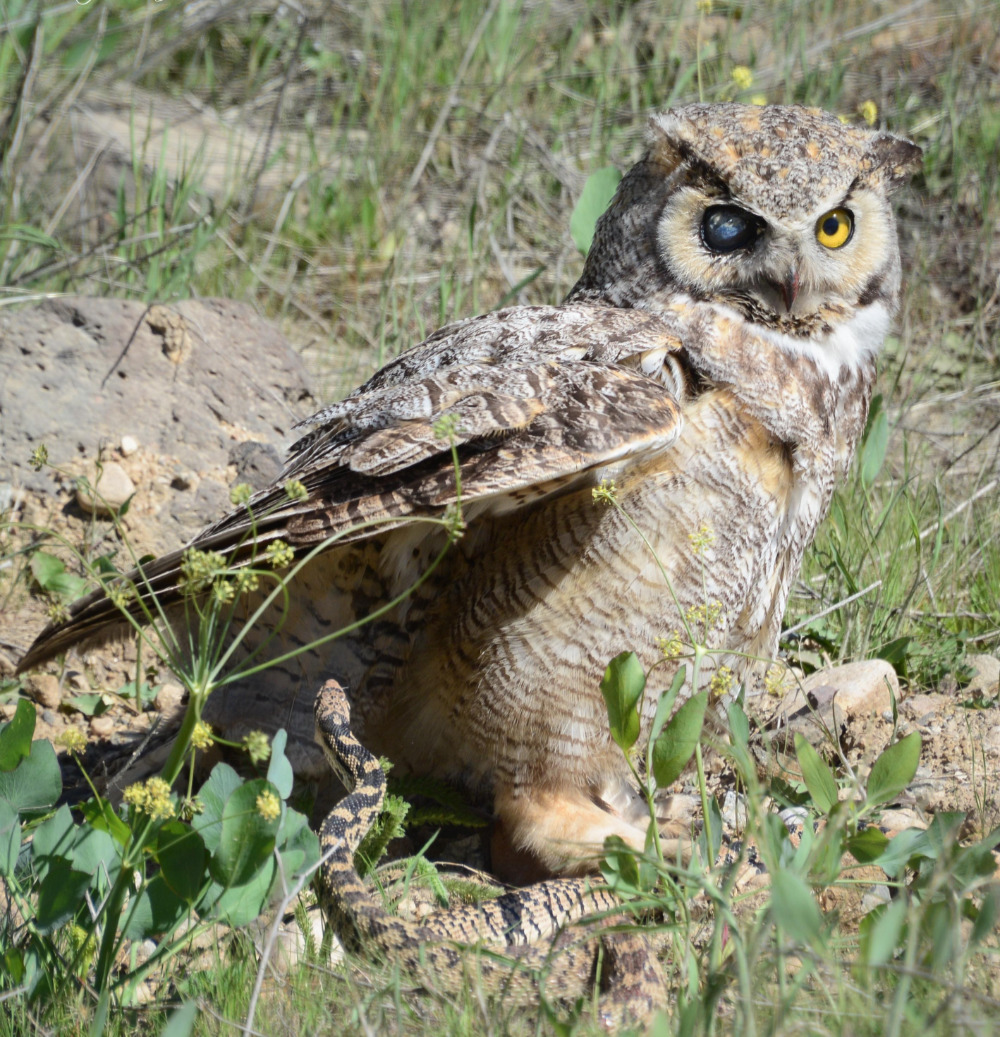The European Eagle Owl – The Giant of the Night Skies
With blazing orange eyes, massive wings, and ear tufts that silhouette against the dusk, the European Eagle Owl (Bubo bubo) is one of the most impressive and awe-inspiring owls in the world. It is among the largest living owls, a true apex predator of Europe and Asia.
Regal, mysterious, and steeped in legend, the European Eagle Owl has captured human imagination for centuries. In folklore it has been feared as a bird of ill-omen, admired as a symbol of wisdom, and respected as a skilled and relentless hunter.
 Quick Facts – European Eagle Owl (Bubo bubo)
Quick Facts – European Eagle Owl (Bubo bubo)
- Height: 60–75 cm (2–2.5 feet)
- Wingspan: 160–188 cm (over 6 feet)
- Weight: 1.5–2.5 kg for males, 3–4.2 kg for females
- Appearance: Striking orange eyes, bold ear tufts, mottled brown plumage
- Range: Across Europe, Russia, the Middle East, and Asia
- Habitat: Cliffs, forests, open hillsides, rocky landscapes
- Diet: Rabbits, hares, ducks, crows, foxes, and even small deer fawns
- Voice: Deep, resonant “ooh-hu” call, carrying up to 4 km
- Lifespan: 20 years in the wild, up to 60 in captivity
Appearance and Adaptations
The European Eagle Owl is a bird that commands attention. Standing over two feet tall, with a wingspan as wide as a tall man’s height, it can weigh over 4 kilograms – heavier than most newborn babies. Females, as in many raptors, are the larger sex, sometimes nearly twice the weight of a smaller male.
Its mottled feathers provide camouflage against rocky cliffs and forested slopes, while its talons rival those of a golden eagle in size and strength. At full spread, those talons can cover the face of a grown adult.
But perhaps its most striking feature is its piercing orange eyes – glowing like embers in the half-light, an unforgettable sight for anyone who encounters one.
 Range and Habitat
Range and Habitat
The European Eagle Owl is found across a vast range: from Portugal to Scandinavia, and eastward across Russia, the Middle East, and Asia as far as China.
It favours cliffs, rocky outcrops, and steep valleys for nesting, but hunts across open countryside, forests, and semi-desert regions. Unlike the Barn Owl, which thrives near human habitation, the Eagle Owl tends to keep to wilder, less disturbed places.
Hunting and Diet
A master predator, the European Eagle Owl feeds on an astonishing variety of prey.
- In Europe, they often hunt rabbits and hares, each weighing up to half the owl’s own body mass.
- They also take ducks, pheasants, crows, and even other birds of prey.
- Remarkably, they are strong enough to kill foxes, domestic cats, and even young roe deer fawns.
Hunting usually takes place at dusk. With broad wings, silent flight, and phenomenal eyesight, they swoop down on unsuspecting prey with devastating force. Their talons exert a crushing grip measured in hundreds of pounds per square inch – enough to dispatch animals much heavier than themselves.
 Did You Know?
Did You Know?
The European Eagle Owl’s call is so deep and resonant that it can be heard up to 4 kilometres away on a still night.
Breeding and Nesting
Unlike many owls, the European Eagle Owl does not build a nest. Instead, it chooses a scrape on a cliff ledge, a hollow in a slope, or sometimes even the ground among rocks.
The female lays 2–4 eggs in late winter. She incubates while the male hunts, bringing prey that can sometimes outweigh the female herself – rabbits, large birds, or hares.
The chicks hatch after about 35 days and grow rapidly, fed on this rich diet of meat. By 9–10 weeks they can fly, but often remain near their parents into the autumn.
The Voice of the Eagle Owl
The Eagle Owl’s deep, booming call is unforgettable – a low “ooh-hu” that echoes across valleys. Males and females often duet, their calls carrying vast distances through the night air.
Other sounds include harsh barks, growls, and the beak-clacking threat display of a defensive adult. For those unfamiliar with owls, hearing this sound in the dark could be a frightening experience, which partly explains its sinister reputation in folklore.
Folklore and Cultural Significance
The European Eagle Owl has long held a place in European legend.
- Ancient Europe: Owls were associated with death and the underworld. The Eagle Owl’s haunting call led many to believe it was a messenger of misfortune.
- Medieval times: Farmers often saw the owl as a competitor, stealing poultry, and thus persecuted it heavily.
- Myth and superstition: In parts of Central Europe, the Eagle Owl was believed to be a witch in disguise. Others thought its call predicted storms or calamities.
- Modern era: With the growth of conservation, the Eagle Owl has shifted from being feared to being admired as a symbol of wilderness and strength.
How big is a Eurasian Eagle Owl?
One of the world’s largest owls, it stands 60–75 cm tall, with a wingspan of 160–188 cm. Females are heavier than males, often weighing over 4 kg – about the size of a domestic cat.
What do Eurasian Eagle Owls eat?
They are powerful hunters that feed on mammals such as rabbits, hares, and rodents, as well as birds, snakes, and even other raptors. Their diet is extremely varied and depends on local prey.
Where do Eurasian Eagle Owls live?
They range across much of Europe and Asia, from rocky cliffs and forests to deserts and tundra. The Siberian subspecies thrives in snowy, northern landscapes.
Are Eurasian Eagle Owls dangerous to humans?
These owls are not a threat to people, but they are fiercely protective parents. They may swoop at intruders who come too close to their nest.
Why do Eurasian Eagle Owls have orange eyes?
Their striking orange eyes help them see in dim light. Unlike nocturnal owls with dark eyes, eagle owls are active in twilight as well as at night.
How long do Eurasian Eagle Owls live?
In the wild, they can live around 20 years, while in captivity – where they are safe from predators and food is reliable – they may live over 50 years.
Are Eurasian Eagle Owls kept in falconry?
Yes, they are popular in falconry and education displays because of their immense size and dramatic appearance. However, they require expert handling and large facilities.
Do Eurasian Eagle Owls live in the UK?
They are not native to Britain, but a small number of escaped or released eagle owls have bred in the wild. Their presence is sometimes controversial because of concerns about their impact on native wildlife.
Conservation and Threats
Once persecuted to near-extinction in parts of Western Europe, the European Eagle Owl has made a strong comeback thanks to legal protection and reintroduction programs.
Threats today include:
- Electrocution on power lines
- Secondary poisoning from rodenticides
- Loss of prey in intensively farmed landscapes
- Illegal persecution in some regions
Encouragingly, the species has recolonised countries like Germany, Switzerland, and even parts of the UK, where small numbers of wild Eagle Owls now breed after escapes or deliberate releases.
Why the Eagle Owl Matters
As a top predator, the European Eagle Owl plays a key role in balancing ecosystems. By preying on rabbits and rodents, it helps control populations that could otherwise surge.
It also embodies the wild spirit of Europe’s landscapes – an ambassador for nature’s resilience and the importance of conserving large predators.
For falconers and bird enthusiasts, the Eagle Owl has become a symbol of majesty and awe. Its sheer size and power make it a favourite at demonstrations, though working with such a bird demands respect and experience.
How to Spot a European Eagle Owl
In the wild, seeing an Eagle Owl is a rare privilege. Look for:
- Vast, broad wings gliding at dusk near cliffs or open valleys
- Huge orange eyes peering from a rocky ledge
- Pairs calling in duet on winter nights
Because they are mainly nocturnal and avoid humans, most people encounter Eagle Owls in aviaries, falconry centres, or conservation programs rather than in the wild.
Pull Quote
“The European Eagle Owl – heavier than a newborn child, stronger than a fox, and as silent as a ghost. A monarch of Europe’s skies.”
Owls in Folklore and Literature
The Tawny Owl has a long and colourful place in human culture.
- Folklore: In many parts of Britain, hearing a Tawny Owl was once considered a bad omen, even a harbinger of death. Yet in other traditions, the owl was seen as a wise guardian of the night.
- Shakespeare: In Love’s Labour’s Lost, he refers to “the owl for all his feathers was a-cold, the parson’s saw” – linking its call to winter nights.
- Children’s stories: The kindly “Owl” of Winnie the Pooh is often imagined with the Tawny’s round features and nocturnal wisdom.
- Ghost stories: Its call has been used for centuries to create atmosphere in tales of haunted woods and lonely moors.
The dual reputation of the Tawny Owl – both sinister and wise – reflects the way humans have projected our own fears and hopes onto this mysterious bird.
Eagle Owls and Snakes – A Predator’s Challenge
The European Eagle Owl is one of the few raptors in Europe and Asia capable of taking on snakes, including large and venomous species. At first glance, this seems surprising: owls are naturally farsighted, meaning their close-up vision isn’t as sharp. Wouldn’t that make them vulnerable to a fast strike?
In reality, eagle owls are well equipped for the task.
Hunting Adaptations
-
Head movements for depth perception – By bobbing and weaving their heads, eagle owls judge distance and movement even when close vision is blurred.
-
Acute hearing and motion detection – The faint rustle of scales in grass or leaves can be enough to alert them. Their ears give them an edge where their eyes cannot.
-
Attack strategy – Rather than hovering close, they swoop from above and pin the snake with immense talons, keeping their head and body safely out of strike range.
-
Natural protection – Their legs are heavily feathered, and their toes are covered in thick, scale-like skin that helps shield them from bites.
Success as Snake Hunters
These adaptations make the European Eagle Owl a formidable snake predator. In parts of their range, especially warmer regions, snakes can form a regular part of their diet. Even vipers are not immune from an owl’s ambush. By striking hard and fast, the owl prevents the snake from mounting an effective defense.
The next time you picture an owl as a silent, ghostlike hunter of small mammals, remember that the eagle owl also has the courage — and the equipment — to take on reptiles that many other predators avoid.
Eagle Owls and Other Raptors – Kings of the Skies
The European Eagle Owl doesn’t just prey on mammals and reptiles. As one of the world’s largest and most powerful owls, it has been recorded hunting other birds of prey — even hawks, falcons, and smaller owls. This behaviour underlines its role as a true apex predator.
How Do They Do It?
-
Ambush Advantage – Eagle owls use their silent flight to take rival raptors by surprise, often attacking at roosts or nests at night when their victims are least alert.
-
Power and Size – With females weighing over 4 kg and wingspans approaching 2 metres, eagle owls simply overpower smaller birds of prey in a direct clash.
-
Territorial Instinct – Sometimes these attacks are less about food and more about eliminating competition from their hunting grounds.
Not Always About Predation
Although capable of taking other raptors, eagle owls don’t target them routinely. Mammals like rabbits and hares remain their staple prey. But their willingness and ability to strike at fellow predators illustrates just how high they sit in the natural hierarchy.
In areas where they are established, eagle owls exert a powerful influence on the balance of other birds of prey — reinforcing their reputation as the undisputed rulers of Europe and Asia’s nocturnal skies.


